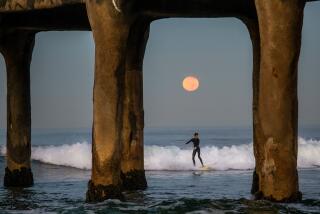It’s Once in a Blue Moon All Over Again
- Share via
Look up into the sky tonight and you will see an event that happens only--dare we say it?--once in a blue moon.
The full moon you spot will be the second full moon of the month, a phenomenon known in modern folklore as the “blue moon”--even though it will appear its usual white or ivory color.
“It’s a vagary of the calendar . . . a natural consequence of the moon that is traveling at its own speed and our absolutely bonkers calendar,” said Ed Krupp, director of the Griffith Observatory.
Two full moons in one month actually occur about once every 2 1/2 years, clearly more often than the blue-moon phrase suggests. What makes tonight’s blue moon distinct is that it follows closely on the heels of January’s two full moons, making 1999 a double blue-moon year, something that happens only four to six times a century, astronomers say.
The last time there was a double blue moon year in the Pacific time zone was 1980; the next won’t happen until 2018.
Philip Hiscock, folklore archivist at the Memorial University of Newfoundland in Canada, has traced the lineage of the term “blue moon” for several years.
In his research, he discovered at least nine different uses of the term “blue moon,” including the familiar “once in a blue moon,” dating back to the 16th century.
Astronomers consider the blue moon a nonevent--just another full moon. Hiscock and others readily admit it is a cultural, rather than a scientific, phenomenon.
“Just because it’s modern and silly doesn’t mean it isn’t entertaining. This prompts people to begin thinking about the moon, the calendar, about how light is scattered,” Krupp said.
“In my view that’s great!”






